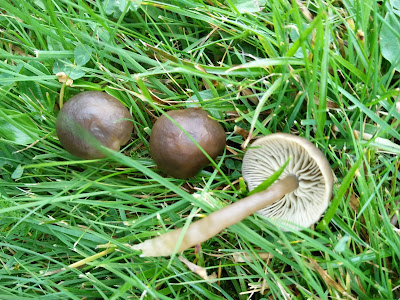I found another Pink Waxcap Porpolomopsis calyptriformis in the same spot where we'd found them previously, in perfect condition. Swoon!
As well as a fresh crop of Parrot Waxcaps Gliophorus psittacinus in same spot where we'd had them before, there were at least two more patches on the south side of the church. I do love these lubricous little characters.
Nearby I found a solitary and slightly sad-looking fruit body lying the grass. A waxcap, I presume, but the decurrent gills made me think this must be something different from the nearby Parrots.
I brought it home for a closer look. The stem seems dry to me, but that might be because it's a bit old.
Looking in 'The genus Hygrocybe (2nd revised edition)' by Boertmann, I see there are several yellow species with decurrent gills, including H. ceracea and H. insipidia (and H. vitellina, but I think I can rule that one out, as it has a distinctive viscid gill edge).
I was hoping the spores would clinch it. They're 6.5-7 x 3.5-4 microns, Q = 1.6-2.1. Which is within range for both H. ceracea and H. insipidia. Boertmann notes that H. ceracea is characterised microscopically by "narrow, usually constricted spores". Well...
 |
| Spores. 1000x magnification in water. |
 |
| Spores. 1000x magnification in water. |
Possibly also worth noting that after two days sitting on the side in my spare room, it's started to turn grey where it's been handled.
I suspect this mushroom is also a 'good one'.
The spores are 4.5-5.5 x 3.7-4.2 microns, Q = 1.2-1.3. They are also inamyloid.
 |
| Spores. 1000x magnification in water. |
I'm thinking this must be Crazed Cap Dermoloma cuneifolium?
Not sure where to start with this one. Brown, hygrophanous cap.
Gill attachment adnexed (?). The white gills have gone a slightly yellowish grey-brown with age. White spore print.
The spores are a bit difficult to make out. The handful I've measured were 5.4-6.2 x 3.7-4.8 microns.
Here they are in Melzers.
 |
| Spores at 400x magnification, in Melzers reagent. |
I'm wondering if I've got a Lyophyllum of some kind...
Finally I had this slender clitocyboid type thing, which has a white spore print. Stuck on this one!
For the record
Date: 12/11/2018
Records to be submitted to SxBRC for High Weald Waxcap Project













No comments:
Post a Comment